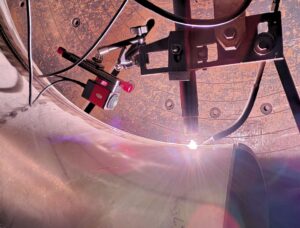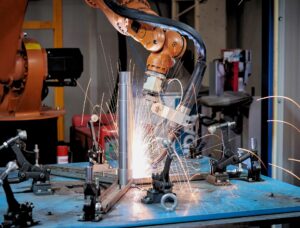Welding is an essential but inherently hazardous task. With intense heat, blinding light, toxic fumes, and the risk of arc flash, operator safety is always a top concern. At the same time, unexpected defects or rework can cause production delays and inflate costs. The solution? Smarter monitoring. Welding cameras and weld monitoring systems are transforming how industries approach both safety and efficiency. From MIG welding and TIG welding to robotic welding and plasma arc welding, these tools provide real-time oversight that protects operators and keeps production on schedule. In this post, we’ll look at how welding cameras improve safety and its critical role in reducing hazards, minimizing downtime, and improving welding quality across the board.
The Safety Challenges in Welding
Before we dive into the solution, here are just a few safety risks welders face daily:
- Arc Flash – Exposure to intense ultraviolet and infrared rays from the arc welding process can cause serious eye damage.
- Toxic Fumes & Gases – Welding in enclosed or poorly ventilated spaces increases exposure to hazardous particles.
- High Temperatures & Spatter – Burns from molten metal, sparks, and hot surfaces are a constant threat.
- Manual Inspection in Risky Areas – Inspecting welds in confined, elevated, or hazardous environments adds to the danger
How Welding Cameras Improve Safety
1. Remote Monitoring Keeps Welders at a Safe Distance
With a camera for welding, operators can monitor the welding process in real-time from a safe, shielded workstation—no need to be inches away from the arc.
Benefits:
- Reduces exposure to UV radiation and hot metal
- Allows observation in confined or hazardous spaces without physical presence
- Supports safer operations in robotic welding and automated systems
2. Improved Visibility and Weld Inspection Without Contact
Welding visual inspection becomes safer and more accurate when it’s done through a camera system. Operators can detect flaws, adjust positioning, and review footage without touching the hot workpiece.
- Detect weld defects such as porosity, undercut, and slag inclusion
- Monitor real-time arc welding images to identify anomalies early
- Apply non-contact welding inspection techniques for higher precision
3. Reduced Need for Rework Minimizes Exposure
By catching errors during the weld instead of after, welding cameras drastically reduce the number of times operators need to go back and make corrections—saving time and keeping them out of harm’s way.
Examples:
- In MIG and MAG welding processes, cameras help maintain proper travel speed and arc stability.
- In TIG welding (Tungsten Inert Gas), cameras verify shielding gas coverage and bead uniformity in real time.
How Welding Cameras Reduce Downtime
1. Fewer Defects Mean Less Rework
Defective welds are one of the most common causes of production delays. A weld monitoring system helps ensure consistent welds by tracking heat input, alignment, and penetration as it happens.
Outcome:
- Reduce production halts caused by failed inspections
- Prevent cumulative delays in metal arc welding and plasma arc welding operations
- Boost first-pass yield rates
2. Faster Troubleshooting
When issues occur, welding cameras provide a clear record of what happened—frame by frame. Instead of guessing, supervisors can pinpoint the root cause immediately and take corrective action.
Application:
- Review arc welding images to identify process breakdowns
- Adjust settings like voltage, amperage, and wire feed speed based on video evidence
- Accelerate training and skill development using recorded welds
3. Increased Uptime with Predictive Maintenance
Modern welding equipment integrated with monitoring cameras can alert teams to irregularities—like inconsistent arcs or heat signatures—before they become bigger problems.
With real-time monitoring, you can:
- Spot torch misalignments or wear early
- Schedule maintenance proactively
- Avoid unexpected shutdowns
A Safer, Smarter Approach to Welding
Whether you’re managing a fabrication floor, offshore platform, or aerospace assembly line, the combination of safety and uptime is non-negotiable. Welding cameras provide a powerful advantage:
- Enhance operator safety by reducing direct exposure
- Boost productivity by minimizing rework and troubleshooting time
- Support compliance through detailed welding inspection documentation
Conclusion: Invest in Safety, Reap the Rewards
Welding doesn’t have to mean choosing between quality and safety. With welding camera systems from a trusted welding camera manufacturer, you get both. Real-time visibility means fewer risks, faster work, and better welding quality across the board.
Mecaweld offers industry-grade weld monitoring cameras and inspection tools designed to protect operators and streamline production. From laser welding to robotic welding, our systems help reduce hazards and downtime—so you can weld smarter and safer.
Contact us today to learn how our camera solutions can improve your welding operations.



